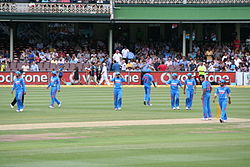Indian ethnicity refers to the ethnic makeup of the 1.4 billion people who trace their roots to India. The ethnic landscape here is one of the most complex of any country on earth. This diversity is a product of India being a subcontinent with the largest population of any other nation state as well as the varied ways in which different regions developed. For instance, the north and north-west of the country experienced waves of migration over the centuries from parts of Central Asia. Most notably, during the sixteenth century when the rulers of the Timurid Empire of Transoxiana, a people ultimately descended from the Mongols, conquered this part of India. They established the Mughal Empire which would rule over much of northern and north-western India until the British conquered them in the late eighteenth and early nineteenth centuries.[1]
The southern parts of the subcontinent, being relatively isolated from the rest of Asia, had their own ethnic development. Finally, the north-eastern parts of India have specific ethnic nuances too, with the Bengalis being paramount in many places. Yet while the ethnic landscape of India is variegated, the country is substantially united through some common cultural and social systems. One such commonality, Hinduism, is not only the dominant religion in the country, but also the basis of much of India’s culture, social systems, and way of life, including its own unique calendar.[2]
Research your ancestors on MyHeritage
Indian history
India is one of the world’s greatest centers of civilization. In the mid-third millennium BCE the Indus Valley Civilization began to develop into an urban culture with cities, urban planning, organized water-supply systems, drains and sewers, metallurgy, pottery and other crafts. These cities, much like the contemporary Sumerian cities of Mesopotamia, held upwards of 50,000 or 60,000 people.[3] In centuries that followed, during the latter stages of the Indus Valley Civilization and the Vedic Period (c. 1500 BCE – 500 BCE), Hinduism began to emerge as a religious and cultural movement which would unite the subcontinent in times to come. This was mirrored in the fourth and fifth centuries CE when the Gupta Empire managed to unite a vast swathe of modern-day India under its rule.

During the medieval period the subcontinent fragmented into dozens of different states and sultanates. Often these rose to positions of considerable prominence for periods of time, notably the Chola Empire, which at its height in the eleventh century controlled much of southern India and Sri Lanka, and had influence further to the west towards the Malay Peninsula and the island of Sumatra.[4] Further north things were more fragmented, but unity was achieved here in the sixteenth century when Babur, the leader of the Timurid Empire, a ruler of one of the successor states to the Mongol Empire, who was born in what is now Uzbekistan, conquered northern India. The Mughal Empire would constitute the largest power in India for the next two and a half centuries, in the process profoundly changing the religious and ethnic landscape of northern and north-eastern India as Islam became the religion of the ruling elite.[5]
By the time Babur was conquering northern India, the first European colonial powers had reached the subcontinent by rounding India. The Portuguese developed a significant presence in the shape of trading stations and military outposts at key locations along the coast of India like Bombay. Eventually the British, Dutch, French, and others became interested in acquiring territory in India. It was the English who were most successful, especially once Robert Clive joined the English East India Company and began a rapid series of conquests in Bengal and other parts of northern and north-eastern India following the Battle of Plassey in 1757. Over the next hundred years the East India Company conquered all of India and Pakistan and administered it, a remarkable arrangement whereby a private corporation governed a substantial proportion of the world’s people.[6]
Exactly a century after Plassey, in 1857, a massive mutiny broke out across India against Company rule. In the aftermath, the British government decided it needed to administer India directly. Thus was born the British Raj, and Queen Victoria of Britain eventually was made Empress of India. The United Kingdom would govern India directly for the next ninety years, but throughout that time it faced growing calls to grant India greater self-determination or even independence, a movement that was led by Mahatma Gandhi from early in the twentieth century onwards. Eventually independence came in 1947 after the Second World War, with the Muslim parts of what had been the Raj formed into Pakistan, which eventually split into Pakistan and Bangladesh. The late 1940s also saw a massive migration of Muslims out of India and into Pakistan, but even so India is still home to over 200 million Muslims today. Ethnically, modern India is a patchwork of different peoples, but united to a considerable extent by Hindu nationalism.[7]
Indian culture

India has a very diverse culture, but with some unifying factors, especially Hinduism. While peoples in different parts of India may speak different languages, follow different local customs and eat different types of food, they have the common culture of Hindu religious festivals and beliefs. For instance, Diwali and Holi, the festivals of light and colors are as significant across the subcontinent as holidays such as Christmas and Thanksgiving in the United States, or Easter in some Christian countries. While Indian cuisine is extremely diverse, it has common facets across the vast country, notably the heavy use of spices and herbs and the popularity of vegetarian dishes. The country’s sports culture has been greatly impacted by British colonial rule. Cricket, for instance, is more popular here than in any other country in the world, and the Indian Premier League is the biggest cricket league in the world.[8]
The Indian film industry, known as Bollywood as a portmanteau of Bombay, where it is largely based, and Hollywood, in imitation of the heartland of the American film industry. Bollywood is actually the largest film industry in the world in terms of films made and tickets sold, but second to Hollywood in terms of revenue. Bollywood is possessed of unique elements and style which mark it as distinct from other national film industries.[9]
Indian languages
Inevitably, over such a vast country, with a very complex history and many different ethnic groups, the lingual landscape of India is far from uniform. The official state language, as prescribed under article 343(i) of the Indian constitution, is Hindi in Devanagari script. This is in effect the state language, while English is the second language of India, reflecting its colonial history during nearly two centuries of British rule. Over 10% of the population speaks English. Hindi is the dominant language only in the northern and central regions of the subcontinent. Some of the most populace provinces, including Uttar Pradesh, Bihar and Madhya Pradesh are located in these regions, ensuring that over 40% of the populace are primarily Hindi speakers. Bengali is the first language of nearly 100 million Indian citizens, chiefly located in the densely populated West Bengal province of north-eastern India. Marathi is spoken by over 80 million people in the large province of Maharashtra in central-western India, while a number of Dravidian languages including Telugu, Tamil, Punjabi and Kannada have tens of millions of native speakers in different parts of India.[10]
See also
Explore more about Indian ethnicity
- MyHeritage DNA at MyHeritage
- Ethnicities around the world at MyHeritage
- What Is My Ethnicity? How MyHeritage Estimates Ethnicities at MyHeritage Knowledge Base
- Where's My Ethnicity?!: Why An Ethnicity Might Not Show Up In Your DNA (and How To Find Evidence Of It Anyway) at MyHeritage Knowledge Base
References
- ↑ https://www.jstor.org/stable/20079408
- ↑ https://www.bbc.co.uk/religion/religions/hinduism/history/history_1.shtml
- ↑ https://www.worldhistory.org/Indus_Valley_Civilization/
- ↑ https://www.nationalgeographic.com/travel/article/gangaikondacholapuram-southern-india-chola-dynasty-ponniyin-selvan-1
- ↑ https://www.bbc.co.uk/religion/religions/islam/history/mughalempire_1.shtml
- ↑ https://www.worldhistory.org/East_India_Company/
- ↑ https://www.worldhistory.org/East_India_Company/
- ↑ https://www.hindustantimes.com/75th-independence-day/cricket/how-cricket-became-india-passion
- ↑ https://www.nfi.edu/what-is-bollywood/
- ↑ https://www.worldatlas.com/articles/the-most-widely-spoken-languages-in-india.html


